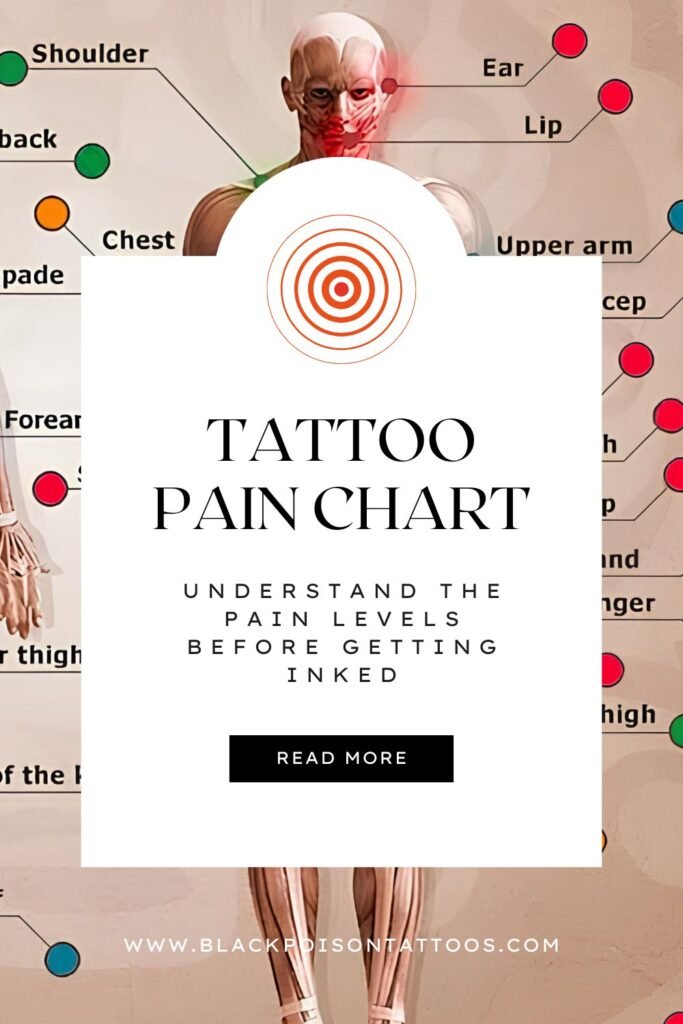If you’re planning to get a tattoo, understanding the pain levels is crucial. This detailed tattoo pain chart illustrates the least to most painful areas of the body, helping you make an informed decision. Whether you’re a first-timer or a seasoned tattoo enthusiast, knowing what to expect can prepare you both physically and mentally. Discover which body parts are the most sensitive, how pain varies by location, and tips to manage the discomfort.
Black Poison Tattoos offers expert tattoo services with precision and care, ensuring a comfortable experience no matter where you choose to get inked.
🧐 What Is a Tattoo Pain Chart?
A tattoo pain chart is a visual guide illustrating the varying pain levels experienced when getting tattooed on different parts of the body. Since pain tolerance varies by person, this chart offers a general outline to help you anticipate what to expect.

This tattoo pain chart highlights the least to most painful areas of the body, guiding individuals in their tattoo placement decisions.
The chart categorizes body areas into four pain levels:
- 🟢 Least Painful Areas: Forearm, shoulder, and calf
- 🟡 Moderate Pain Areas: Upper arms, thighs, and back
- 🟠 More Painful Areas: Ribs, knees, and ankles
- 🔴 Most Painful Areas: Hands, feet, spine, and genitals
💥 Tattoo Pain Levels by Body Part
🟢 Least Painful Areas
If you’re a first-timer, consider placing your tattoo in one of the less painful spots. These areas have thicker skin, fewer nerve endings, and more padding, making the experience more tolerable.
- Shoulder: A popular location for tattoo beginners due to minimal pain.
- Forearm: With ample muscle and low nerve density, the forearm is one of the least painful areas.
- Calf: Padded with muscle, making the pain manageable.
💡 Pain Level: 2-3/10
Ideal for: Large and intricate tattoo designs.
🟡 Moderate Pain Areas
Moderate pain zones are perfect for those with prior tattoo experience. The skin here is thinner, but still offers some padding.
- Upper Arm: Slightly more sensitive but still manageable for most people.
- Thigh: Although fleshy, the inner thigh can be tender.
- Back: The upper and mid-back have moderate pain levels, while the spine area is more painful.
💡 Pain Level: 4-6/10
Ideal for: Medium to large tattoos.
🟠 More Painful Areas
For experienced tattoo lovers, these areas can be challenging due to thinner skin and more nerve endings.
- Ribs: One of the most painful locations due to lack of cushioning.
- Knees: The thin skin over bone makes this area sensitive.
- Ankles: Painful due to proximity to bones and less fat.
💡 Pain Level: 7-8/10
Ideal for: Small, detailed tattoos.
🔴 Most Painful Areas
These areas should be reserved for those with a high pain tolerance. The thin skin, abundance of nerve endings, and closeness to bones make them highly sensitive.
- Hands and Fingers: Extremely painful due to the number of nerve endings.
- Feet: The bony structure makes this area highly sensitive.
- Genitals: The most painful area, recommended only for the bravest tattoo enthusiasts.
💡 Pain Level: 9-10/10
Ideal for: Small and minimalistic designs.
💡 Tattoo Pain Management Tips
- Hydrate and Eat Well: Being hydrated and having a full stomach reduces discomfort.
- Use Numbing Cream: For sensitive areas, numbing creams can reduce pain.
- Practice Deep Breathing: This helps calm the nervous system and reduces pain perception.
- Choose an Experienced Artist: Skilled artists can work efficiently, reducing tattooing time and pain.


